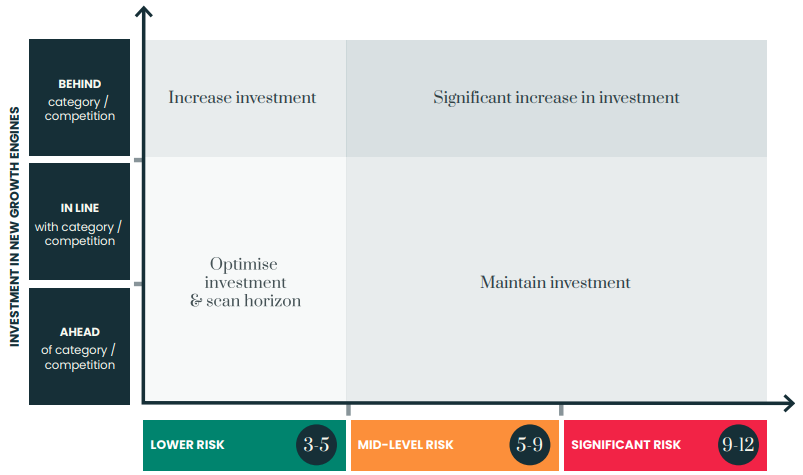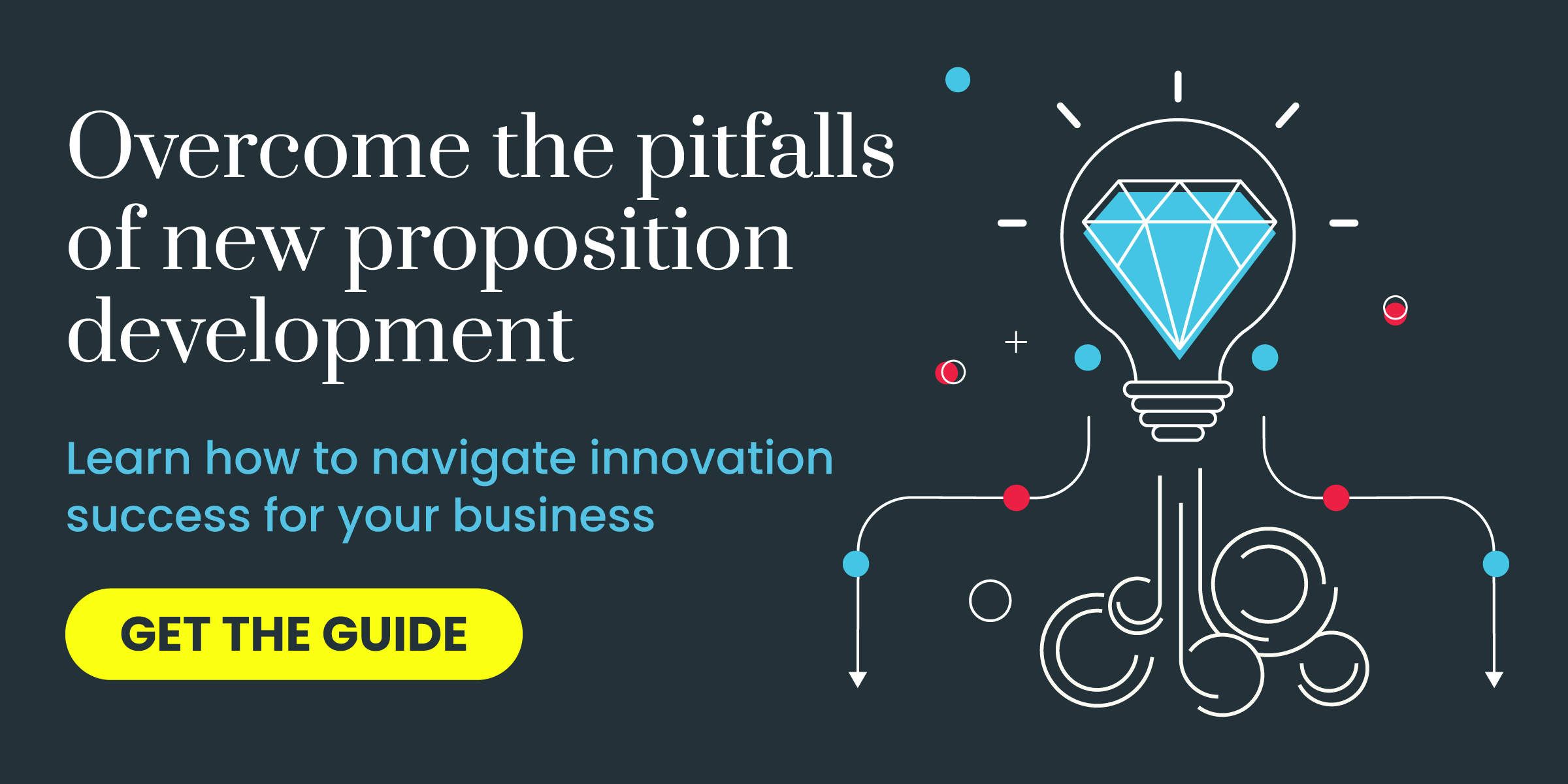The main causes of innovation inertia in large organisations
Innovation inertia can have a debilitating effect. Discover four common factors that create such an external force and why innovation is vital for sustainable business growth. Like the proverbial toad in the hot water pan, you don’t realise that you are being slowly cooked, until it’s too late to jump.

While most companies understand the importance of developing new innovation, they can be cautious about the associated risk and cost. If restraint turns into inactivity, then the real dangers of stagnation could prove more serious for future business health.
When it comes to innovation, business leaders are faced with a dilemma. On the one hand, they understand that new proposition development is vital for sustainable growth. Simply, companies that invest in innovation survive and thrive better than those that don’t. In the face of constant changes across regulation, technology, market disruption and rapidly changing customer expectations, no business can afford to stand still. They must work harder, just to keep pace. Innovate now to beat the competition tomorrow.
> HELPFUL GUIDE: Navigating innovation success and overcome the pitfalls of new proposition development
If only business were that easy…Decision makers also know that innovation is risky. The attrition rate of creativity can make directors – and especially financial directors – blink. Just one in three new business models, product and service innovations prove successful. When they go wrong, it can get expensive. Once bitten, twice shy. Far better to maintain profitability today, is the counter point to gambling on tomorrow. Let’s put our faith in effective sales, cost-cutting and efficiencies to meet the quarterly targets.
How to read the signs of innovation inertia
However, this risk-averse approach may prove riskier in the longer term. Companies that opt to mothball their new growth engines can ultimately enter a vicious circle. Yes, cost reductions and entrenchment in the current model might maintain turnover in the near term. But as the business context changes, so the current model becomes outdated and less profitable. Now, there is less cash (and time) to take new concepts to market – and so the business closes in on its old ways still tighter. You know how this story ends.
The need to adapt in today’s business environment feels more important today than ever before. Business leaders need to widen their field of vision and make a virtue out of self-criticism. What’s successful in 2024 is unlikely to be as successful in 2028, let alone 2035.
Those that can’t or won’t adapt may find themselves in a state of innovation inertia. They will maintain the same direction at the same pace until an external force knocks them off line. The extent of the damage caused by this collision may well determine their progress or decline in the years to come.
There are four common factors that create such an external force. And by ignoring them, companies become less adaptable and more vulnerable.
1. Customer Apathy
Losing touch with the changing needs of customers is a dangerous situation. Or, to put it more positively, when companies invest in staying ahead of customer expectations, they are rewarded with competitive advantage.
The problem is that customer apathy is often hard to spot. A buoyant market or investor confidence can give the allusion of happy customers, when actually their interest in your products or services is waning.
Solution:
It is critical that leadership stay close to real customer feedback. All too often leadership teams can get insulated from what customers really think, or distracted by other business priorities. Proximity to the customer is one of the key advantages of smaller disruptors, which is why they are less likely to be impacted by customer apathy.
“I'm not afraid of negative feedback, I think it's literally the most important thing we can get,” said Milly Bagot, co-founder of successful frozen food start-up ByRuby, during a recent panel discussion on value proposition development. “I feel very comfortable with our products, but I really trust the customers.”
This openness to real feedback and proximity to the customer and their needs from business leaders reduces the likilhood if innovation inertia at the top of the business.
2. Regulatory Change
Regulatory change is a key driver of innovation, but all too often companies become too focused on combatting delaying the new standards. Prefering to defend the status quo rather than preparing for the future.
The key for any business facing regulatory pressure is timing. When do you stop defending your current business model and start building the new business model. The pace of regulatory change, impact on customers and implications for your business must be a priority topic ofin every strategy cycle – and it can lead to differing and very challenging views. Some will champion a future focused approach; others will want to protect profitability in the moment.
Solution:
Regulatory war-games and scenario planning are incredibly powerful tools to explore how both established and disruptive competition will react to new regulations. And then use that insight to strengthen your own strategy. This should not be used on a regular basis but is a highly effective tool for getting leadership teams to challenge strategy and explore deeply the potential impacts of regulatory change and the dangers of inertia.
3. Technology Disruption
To use a surfing metaphor, technology is like an endless series of big waves. Those businesses that are well prepared will harness the power of each new wave. Those that are off balance and hesitant will be knocked over by the next wave and the next, and eventually get dumped on the beach.
Some businesses embraced digital transformation; some have been left behind. And we are in the midst of the next wave with the emergence of Genrative AI. As such, some businesses are excited by generative AI as a potential growth engine. Others see it as a threat and beyond their reach, due inertia and a conservarive approach to technology change.
Solution:
Technology change is never easy and something that nearly every business wrestles with. That said we believe that you must regularly benchmark how other companies are harnessing technology and when new waves arrive you have to get small scale pilots moving very fast. Preparing the business that many of these pilots will fail. But the goal is to learn. So the next time you try you are that little bit better. In the next strategy cycle, it is critical that you understand where you sit vs the competition and how many pilots you have up and running.
4. Market Evolution
How mature is your market? Let’s say your business was one of the first to sell air fryers. Your difference to traditional oil fryers was the key selling point. But then the market matured. You needed to be better than the many other air fryers to protect market share. Today, the market for air fryers is becoming saturated (pardon the pun) and so the message is shifting to “we are the cheapest”. Brands are increasingly competing on price..
While that high-scale, low-cost business model works for some companies; it spells disaster for others. Innovation inertia has left them exposed.
Solution:
It is critical to understand when your basis of competition is shifting. At what point does a market shift from product differentiation, to service and experience differentiation to cost differentiation. If you can spot these shifts early and innovate early you will succeed.
How to mitigate the risk of innovation inertia
The need to stay vigilant around customer needs, regulation, technology and the market may seem like common sense, but inertia can have a debilitating effect. Like the proverbial toad in the hot water pan, you don’t realise that you are being slowly cooked, until it’s too late to jump. Far better to interrupt your own innovation inertia than have it abruptly ended by factors beyond your control.
While no two companies have the same priorities and systems; we have fine-tuned a simple framework to help clients sense check innovation inertia risk during their annual planning process.
Against the four key considerations above – customer apathy, regulatory change, technology disruption and market evolution – we dig into the vulnerabilities and strengths to provide a risk factor score:

If the score reflects a significant risk, then it’s time to push new growth engines up the agenda. We can plot the score against the level of investment in innovation, new business model innovation or M&A to see the most effective path to growth. We also help clients to develop their next value propositions.

Innovation inertia sounds destructive – and it can be – but it’s also more common than you might think. The vast majority of companies that have excelled over the long term have experienced plateaus of decline and stagnation, before smelling the coffee and finding fresh impetus. The most important step is recognising the signs of inertia in the first place.


